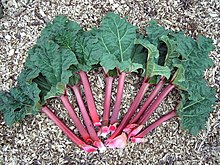**Etymology and Origins**:
– The word ‘rhubarb’ likely derived from Old French ‘rubarbe,’ from Latin ‘rheubarbarum’ and Greek ‘rha barbaron,’ meaning foreign rhubarb.
– The Greek physician Dioscorides used the Greek word ῥᾶ (rha), whereas Galen later used ῥῆον (rhēon), Latin ‘rheum.’
– Cultivation of rhubarb requires rainfall and a cold period of up to 7–9 weeks at 3°C to grow well.
– Chinese used rhubarb root for medicinal purposes over 1,800 years ago.
– Efforts to cultivate rhubarb in Europe increased due to its high value.
**Cultivation and Historical Significance**:
– Hothouse rhubarb is grown in heated greenhouses and is available earlier in the year, being brighter red and sweeter.
– Rhubarb trade became established in medieval Europe through Islamic times.
– Marco Polo discovered rhubarb cultivation in the mountains of Tangut province.
– Rhubarb was expensive in medieval Europe due to high transportation costs.
– Rhubarb stalks vary in color from red to green but color does not affect cooking quality.
**Cultivars and Culinary Uses**:
– Lawrence D. Hills listed favorite rhubarb varieties for flavor, including Hawkes Champagne, Victoria, Timperley Early, and Early Albert.
– Rhubarb stalks can be eaten raw but are commonly cooked with sugar for desserts.
– Rhubarb is used in pies, crumbles, and other desserts due to its strong, tart taste.
– Rhubarb is often used in culinary dishes despite being a vegetable.
– Common uses include stewing with sugar, making pies, desserts, or pickling.
**Nutrition and Traditional Uses**:
– Raw rhubarb is 94% water, 5% carbohydrates, and 1% protein.
– Rhubarb is low in fat and a good source of dietary fiber.
– Rhubarb roots have been used in traditional Chinese medicine as a laxative.
– Rhubarb has been consumed in the Islamic world since the 10th century.
– In Northern Europe and North America, stalks are stewed with sugar.
**Toxicity and Safety Concerns**:
– Rhubarb roots and stems contain anthraquinones like emodin and rhein.
– Long-term intake of anthraquinones has been associated with kidney issues.
– Rhubarb leaves contain oxalic acid, which can lead to kidney stone formation.
– Damage from rhubarb curculio weevils is visible on leaves and stalks.
– Cases of rhubarb poisoning are rare but can be caused by toxic anthraquinone glycosides.
Rhubarb is the fleshy, edible stalks (petioles) of species and hybrids (culinary rhubarb) of Rheum in the family Polygonaceae, which are cooked and used for food. The plant is a herbaceous perennial that grows from short, thick rhizomes. Historically, different plants have been called "rhubarb" in English. The large, triangular leaves contain high levels of oxalic acid and anthrone glycosides, making them inedible. The small flowers are grouped in large compound leafy greenish-white to rose-red inflorescences.
| Rhubarb | |
|---|---|

| |
| Scientific classification | |
| Kingdom: | Plantae |
| Clade: | Tracheophytes |
| Clade: | Angiosperms |
| Clade: | Eudicots |
| Order: | Caryophyllales |
| Family: | Polygonaceae |
| Genus: | Rheum |
| Species: | R. × hybridum (?)
|
| Binomial name | |
| Rheum × hybridum (?) | |
The precise origin of culinary rhubarb is unknown. The species Rheum rhabarbarum (syn. R. undulatum) and R. rhaponticum were grown in Europe before the 18th century and used for medicinal purposes. By the early 18th century, these two species and a possible hybrid of unknown origin, R. × hybridum, were grown as vegetable crops in England and Scandinavia. They readily hybridize, and culinary rhubarb was developed by selecting open-pollinated seed, so its precise origin is almost impossible to determine. In appearance, samples of culinary rhubarb vary on a continuum between R. rhaponticum and R. rhabarbarum. However, modern rhubarb cultivars are tetraploids with 2n = 44, in contrast to 2n = 22 for the wild species.
Although rhubarb is a vegetable, it is often put to the same culinary uses as fruits. The leaf stalks can be used raw, when they have a crisp texture (similar to celery, although it is in a different family), but are most commonly cooked with sugar and used in pies, crumbles and other desserts. They have a strong, tart taste. Many cultivars have been developed for human consumption, most of which are recognised as Rheum × hybridum by the Royal Horticultural Society.
